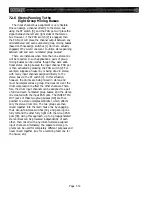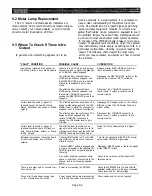
Section 9.
Maintenance
9.1 Cleaning The Console
9.1.1 The Console and Power Supply
Exterior
The console and power supply are painted with a
durable finish. To avoid damage to the paint, control
knobs, switch caps and other parts, DO NOT USE
SOLVENTS. Instead, keep the console as free of dust as
practical. Cover it when not in use, and brush or
vacuum it periodically. The surface may be cleaned with
a soft rag moistened with a dilute solution of non-
abrasive detergent and water. If sticky gum is left on
the panel (from masking tape or other tape used for
channel labeling), it may be necessary to use a special-
ized solvent. In general, rubber cement solvent will
remove tape residue without harming the console;
however, it is your responsibility to test any such
solvent in an inconspicuous location to ensure it does
not attack the console finish or mar any plastic part.
Avoid getting the inside of the console wet from
excessively wet rags. DO NOT USE AEROSOL OR
SPRAY CLEANERS.
9.1.2 Power Supply Air Filters
The reticulated foam air filters on the front of the
power supply screen cooling air as it is drawn through
the unit. When the foam becomes clogged or dirty, it
should be cleaned; check it periodically. Using a 3 mm
allen wrench, remove the four cap screws that secure
each front grille. The foam elements may now be
removed and rinsed in cool water. For greasy or stub-
born dirt, dip the elements in a mild solution of deter-
gent and water, then rinse with clear water. Blot and/or
air dry the elements thoroughly before returning them
to the amplifier. DO NOT USE SOLVENTS TO CLEAN
THE FOAM ELEMENTS.
9.1.3 Pots And Faders
Yamaha DOES NOT recommend the routine use of
any contact cleaners or solvents for cleaning pots or
faders. Such “preventive maintenance” can actually do
more harm than good by removing the lubricating film
on certain pots or faders. While treatment with such
solvents or cleaners may temporarily “clean up” a noisy
control, it can also quickly result in a worn element (due
to lack of lubrication) and even greater, incurable noise.
When a component is to be cleaned, use a very small
amount of an appropriate cleaner, solvent, or pure
isopropyl alcohol. Try to get it on the element, and
immediately work the pot or fader several times all the
way between stops.
In general, cleaning pots and faders is not a trivial
task. Some have carbon elements, some have conductive
plastic elements, and others have cermet elements.
What cleans one part reliably may not work on another.
When in doubt, consult your authorized Yamaha
PM4000 dealer or service center.
9.1.4 The Console Interior
Dust and dirt are the enemy of electronic and
mechanical systems. Switches and controls may wear
prematurely due to the abrasive nature of dirt. A
coating of dust may, in some cases, be conductive and
change the electrical properties of the circuit. Similarly,
dirt accumulations can reduce the thermal dissipation
from heat sinks and transistors, leading to premature
failure. It is advisable to use a soft brush or a vacuum
cleaner with a soft brush attachment to clean the
console periodically. Depending on the environment,
this may be as often as once a month, or as infrequently
as once a year. Use care not to bend or dislodge any
components. Always do this work with the console
power OFF.
If a beverage is spilled into the console, try to blot up
as much excess moisture as possible immediately. If
practical, immediately turn off the power and remove
any affected modules. If not, wait until it is practical,
and then turn off the power and proceed. Rinse con-
taminated parts on the module with distilled water,
shake off the excess water, blot dry with a soft cloth,
and air dry or use a warm (not hot) stream of air from a
hair dryer to facilitate drying. If the console interior is
contaminated, wipe it clean with a water-moistened
cloth.
It is best to clean a spill as soon as possible. Un-
sweetened black coffee is probably the least harmful.
The sugar in sweetened coffee can leave a sticky film on
parts, and cream or milk will leave a residue that can be
very troublesome. Similarly, sweetened soft drinks and
fruit juices can leave sticky residues that degrade the
performance of switches, faders and pots.
NOTE: For module removal and replacement (see
optional functions, Section 6.1)
Page 9-1
Summary of Contents for PM4000
Page 1: ...PROFESSIONAL AUDIO MIXING CONSOLE PM4000 OPERATING MANUAL YAMAHA ...
Page 2: ...PM4000 OPERATING MANUAL ...
Page 7: ...Section 1 Introduction ...
Page 11: ...Section 2 Brief Operating Instruction ...
Page 47: ...Section 3 Specifications ...
Page 51: ...Dimensional Drawings PM4000 Console all versions Page 3 4 ...
Page 52: ...Page 3 5 ...
Page 53: ...Page 3 6 PM4000 Console Rear Profiles ...
Page 54: ...Module Block Diagrams See back of the manual for overall system block diagram Page 3 7 ...
Page 55: ...Page 3 8 ...
Page 56: ...Page 3 9 ...
Page 57: ...Page 3 10 ...
Page 58: ...Page 3 11 ...
Page 59: ...Page 3 12 ...
Page 60: ...Section 4 Installation Notes ...
Page 72: ...Figure 4 13 Cables For Use With Balanced Sources Page 4 12 ...
Page 79: ...SECTION 5 Gain Structure and Levels ...
Page 82: ...Figure 5 1 Dynamic Range and Headroom in Sound Systems Page 5 3 ...
Page 86: ...Section 6 Optional Functions ...
Page 106: ...Section 7 Operating Notes and Hints ...
Page 119: ...Section 8 Applications ...
Page 127: ...Section 9 Maintenance ...
Page 131: ......
Page 132: ...YAMAHA VN02300 ...





































